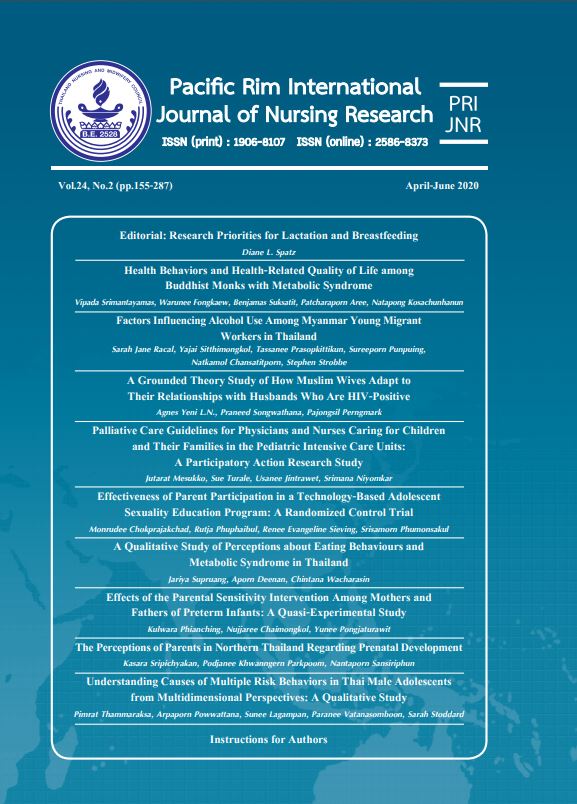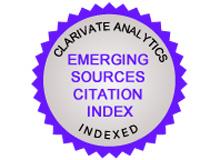Factors Influencing Alcohol Use Among Myanmar Young Migrant Workers in Thailand
Keywords:
Acculturative stress, Alcohol use, Depressive symptoms, Myanmar, Self-esteem, Young migrant workersAbstract
Young migrant workers depict both vulnerability and resilience toward negative health outcomes.A deeper understanding of their needs provides healthcare providers the opportunities to help increase their positive health and well-being.This cross-sectional study examined alcohol use in documented young Myanmar migrants working in Thailand and the factors associated with alcohol consumption.Cooper’s Four-factor Model of Drinking Motives and the Transactional Model of Stress and Coping were used as guiding frameworks.The participants were186young migrant workers from migrant communities in a coastal province near Bangkok,Thailand.Interviews were used for data collection using demographic questionnaire and standardized measures of alcohol use, acculturative stress, depressive symptoms and self-esteem.Data analysis included descriptive statistics and logistic regression.
Results indicated that participants perceived themselves as having positive self-esteem,not currently experiencing discrimination or acculturative stress,and motivated to consume alcohol mainly for positive social interaction rather than for coping or enhancement of positive affect.Almost two thirds of participants reported consuming at least 1 alcoholic drink in the past 12 months.However,92.5% of those were classified as low risk drinkers.Gender,length of stay, and drinking history predicted alcohol use.Our findings add further evidence that the significant differences across studies regarding migrants working in Thailand arise from differences in age, types of work, region in Thailand, registration status, length of stay, peer and community supports.As such, public health policies and programs and health services provided by community nurses related to alcohol use need to be tailored to specific regions within the country and to specific populations of migrant workers based on information from local empirical studies.
References
National Statistical Office. Report of the Migration Survey [Internet]. 2016. Available from: http://statbbi.nso. go.th/staticreport/page/sector/en/02.aspx [Accessed 26th October 2018].
World Health Organization [WHO]. Global Status Report on Alcohol and Health 2018 [Internet] [Internet]. Luxembourg; 2018 [Accessed 10th January 2019]. Available from: https://www.who.int/substance_abuse/ publications/global_alcohol_report/en/
World Health Organization [WHO]. Global Status Report on Alcohol and Health 2014 [Internet]. Luxembourg; 2014 [Accessed 28thth September 2018].
Ellingson JM, Corley R, Hewitt JK, Friedman NP. A prospective study of alcohol involvement and the dual-systems model of adolescent risk-taking during late adolescence and emerging adulthood. Addiction. 2019 Apr 1;114(4):653–61. Available from: https://doi. org/10.1111/add.14489
Wang C, Hipp JR, Butts CT, Jose R, Lakon CM. Alcohol Use among Adolescent Youth: The role of friendship networks and family factors in multiple school studies. PLoS One. 2015;10(3):1-19. Available from:https:// dx.plos.org/10.1371/journal.pone.0119965
Yurasek A, Brick L, Nestor B, Hernandez L, Graves H. The effects of parent, sibling and peer substance use on adolescent drinking behaviors. J Child Fam Stud. 2018;28(1):73–83. Available from:https://dx.plos. org/10.1371/journal.pone.0119965
Sudhinaraset M, Wigglesworth C, Takeuchi DT. Social and Cultural Contexts of Alcohol Use: Influences in a Social-Ecological Framework. Alcohol Res [Internet]. 2016;38(1):35–45. Available from: http://www.ncbi. nlm.nih.gov/pubmed/27159810%0Ahttp://www. pubmedcentral.nih.gov/articlerender.fcgi?artid= PMC4872611.
Tavolacci MP, Ladner J, Grigioni S, Richard L, Villet H, Dechelotte P. Prevalence and association of perceived stress, substance use and behavioral addictions: A cross-sectional study among university students in France, 2009-2011. BMC Public Health. 2013;13(1):1–8. Available from:http://bmcpublichealth.biomedcentral.com/ articles/10.1186/1471-2458-13-724
Marshall EJ. Adolescent alcohol use: Risks and consequences. Alcohol Alcohol. 2014;49(2):160–4. Available from:https://doi.org/10.1093/alcalc/ agt180
Hoyland MA, Latendresse SJ. Stressful life events influence transitions among latent classes of alcohol use. Psychol Addict Behav. 2018;32(7):727–37. Available from: http://doi.apa.org/getdoi.cfm?doi=10.1037/adb000 0412
Cooper ML. Motivations for alcohol use among adolescents: Development and validation of a four-factor model. Psychol Assess [Internet]. 1994;6(2):117–28. Available from: http://doi.apa.org/getdoi.cfm?doi=10.1037/ 1040-3590.6.2.117.
Kuntsche E, Gabhainn SN, Roberts C, Windlin B, Vieno A, Bendtsen P, et al. Drinking motives and links to alcohol use in 13 European countries. J Stud Alcohol Drugs [Internet]. 2014;75(3):428–37. Available from: http:// www.ncbi.nlm.nih.gov/pubmed/24766755.
Conn BM, Ejesi K, Foster DW. Acculturative stress as a moderator of the effect of drinking motives on alcohol use and problems among young adults. Addict Behav. 2017;75:85–94. Available from:https://doi.org/ 10.1016/j.addbeh.2017.06.017
Cano MÁ, Schwartz SJ, Castillo LG, Romero AJ, Huang S, Lorenzo-Blanco EI, et al. Depressive symptoms and externalizing behaviors among Hispanic immigrant adolescents: Examining longitudinal effects of cultural stress. J Adolesc. 2015;42:31–9. Available from:https:// doi.org/10.1016/j.adolescence.2015.03.017
Substance Abuse and Mental Health Services Administration (SAMHSA). 2015 National Survey on Drug Use and Health (NSDUH). Table 2.41B—Alcohol Use in Lifetime, Past Year, and Past Month among Persons Aged 12 or Older, by Demographic Characteristics: Percentages, 2014 and 2015. [Internet]. 2015 [cited 2017 Aug 1]. Available from: https://www.samhsa.gov/data/sites/default/files/ NSDUH-DetTabs-2015/NSDUH-DetTabs-2015/ NSDUH-DetTabs-2015.htm#tab2-41b.
Assanangkornchai S, Sam-Angsri N, Rerngpongpan S, Lertnakorn A. Patterns of alcohol consumption in the Thai population: Results of the National Household Survey of 2007. Alcohol Alcohol [Internet]. 2010;45(3):278–85. Available from: https://doi-org.login.ezproxy.library. ualberta.ca/10.1093/alcalc/agq018
Oo W, Aung M, Soe P, Lwin S, Win M. Alcohol consumption among adult males in urban area of Thanlyin Township, Yangon Region, Myanmar. Int J Res Med Sci. 2015;3(11): 3192–6. Available from: https://doi.org/10.18203/ 2320-6012.ijrms20151161
Park S, Anastas J, Shibusawa T, Nguyen D. The impact of acculturation and acculturative stress on alcohol use across Asian immigrant subgroups. Subst Use Misuse. 2014;49(8):922–31. Available from: https://doi.org /10.3109/10826084.2013.855232
Agic B, Mann RE, Tuck A, Ialomiteanu A, Bondy S, Simich L, et al. Alcohol use among immigrants in Ontario, Canada. Drug Alcohol Rev. 2016;35(2):196–205. Available from: http://doi.wiley.com/10.1111/dar.12250
Lui PP, Zamboanga BL. Acculturation and alcohol use among asian americans: A meta-analytic review. Psychol Addict Behav. 2018;32(2):173–86. Available from: http://doi.apa.org/getdoi.cfm?doi=10.1037/adb000 0340
Khongthanachayopit S, Laohasiriwong W. Accessibility to health services among migrant workers in the Northeast of Thailand. F1000Research [Internet]. 2017;6:972. Available from: https://f1000research.com/articles/ 6-972/v1
Lazarus, Richard S; Folkman S. Stress, appraisal, and coping. Behaviour Research and Therapy. Springer; 1984.
Tse WS, Wong KKF. Comparing of the mediation and the moderation role of coping motive in the relationship between perceived discrimination and hazardous drinking. J Subst Use. 2015;20(6):439–46. Available from: http://www.tandfonline.com/doi/full/10.3109/1465 9891.2014.943816
Srivirojana N, Punpuing S, Robinson C, Sciortino R, Vapattanawong P. Marginalization, morbidity and mortality: a case study of Myanmar migrants in Ranong Province, Thailand. J Popul Soc Stud [Internet]. 2014;22(1):35–52. Available from: http://www2.ipsr.mahidol.ac.th/Journal/PDF/JPSSVol22(1)-Nucharee-Migrant_Morbidity.pdf. https:// 10.14456/jpss.2014.3
Aung H, Perngparn U. Substance use and HIV-related sexual risk behaviors among Myanmar Migrant Workers in Mae Sai, Chiang Rai province, Thailand. J Heal Res [Internet]. 2014;28(1):53–7. Available from: https://www.tcithaijo.org/index.php/jhealthres/article/view/92866
Phyo AZ, Hongsranagon P, Htoo H, Soe K. Factors Inducing Anxiety and Depression among Adult Myanmar Migrant Workers: A Case Study in Ratchaburi Province, Thailand. Heal Res. 2012;26(2):101–3. Available from: https://www.tci-thaijo.org/index.php/jhealthres/article/ view/84676
Soe TZ, Hongsranagon P, Havanond P. Determinants and consequences of alcohol consumption among male adult Myanmar Migrant Workers in Ratchaburi Province, Thailand. J Heal Res [Internet]. 2012;26:27–32. Available from: https://www.tci-thaijo.org/index.php/jhealthres/ article/view/85521
Howteerakul N, Suwannapong N, Than M. Cigarette, alcohol use and physical activity among Myanmar youth workers, Samut Sakhon Province, Thailand. Southeast Asian J Trop Med Public Health. 2005;36(3 PG-790–796):790–6. Available from: https://www.ncbi.nlm.nih.gov/pubmed/ 16124457
Htin K, Howteerakul N, Suwannapong N. Smoking, Alcohol Consumption and Betal-Quid Chewing Among Young Adult. Southeast Asian J Trop Med Public Health [Internet]. 2014;45(4):926–39. Available from: http:// ovidsp.ovid.com/ovidweb.cgi?T=J S&P AGE= reference &D=emed16&NEWS=N&AN=602089205
World Health Organization [WHO]. Management of substance abuse process of translation and adaptation of instruments [Internet]. WHO. 2013. p. 10–2 [Accessed 25th June 2016]. Available from: http://www.who.int/ substance_abuse/research_tools/translation/en/
Williams DR, Yan Yu, Jackson JS, Anderson NB. Racial differences in physical and mental health. J Health Psychol. 2007;2(3):335–51. Available from: http:// journals.sagepub.com/doi/10.1177/1359105397 00200305
Mena FJ, Padilla AM, Maldonado M. Acculturative stress and specific coping strategies among immigrant and later generation college students. Hisp J Behav Sci. 1987; 9(2):207–25. Available from: http://journals.sagepub. com/doi/10.1177/07399863870092006
Radloff LS. The CES-D Scale: A Self-Report Depression Scale for Research in the General Population. Appl Psychol Meas. 1977;1(3):385–401. Available from: http:// journals.sagepub.com/doi/10.1177/0146621677 00100306
Rosenberg M. Society and adolescent self-image. Princeton New Jersey: Princeton University Press; 1989. xxxii, 347.
Silpakit P, Silpakit O. The psychometric property of Rosenberg Self-esteem Scale in Thai Youth. J Ment Heal Thail. 2016;24(1):15–28. Available from: http://doi. org/10.14456/dmhjournal.2016.5
Noom SH, Vergara MB. Acculturative stress, self-esteem, and coping among burmese female migrant workers. In: The 3rd International Conference on Humanities and Social Sciences. Faculty of Liberal Arts, Prince of Songkla University.; 2014.
Babor MT, Higgins-Biddle, J.C. Saunders JB, Monteiro MG. The Alcohol Use Disorders Identification Test: Guidelines for use in primary care. World Health Organization Department of Mental Health and Substance Dependence. 2001.
Groves P. Buddhist approaches to addiction recovery. Religions. 2014;5(4):985–1000.
Isralowitz R, Reznik A. Impact of religious education and religiosity on adolescent alcohol use and risk-taking behavior. Relig Educ. 2015;110(3):303–10. Available from: http://www.tandfonline.com/doi/full/10.1080/ 00344087.2015.1039388
Graber R, de Visser R, Abraham C, Memon A, Hart A, Hunt K. Staying in the ‘sweet spot’: A resilience-based analysis of the lived experience of low-risk drinking and abstention among British youth. Psychol Heal. 2016; 31(1):79–99. Available from: http://www.tandfonline. com/doi/full/10.1080/08870446.2015.1070852
Downloads
Published
How to Cite
Issue
Section
License
Copyright: The Pacific Rim International Journal of Nursing Research, Thailand Nursing & Midwifery Council has exclusive rights to publish, reproduce and distribute the manuscript and all contents therein.








.png)



